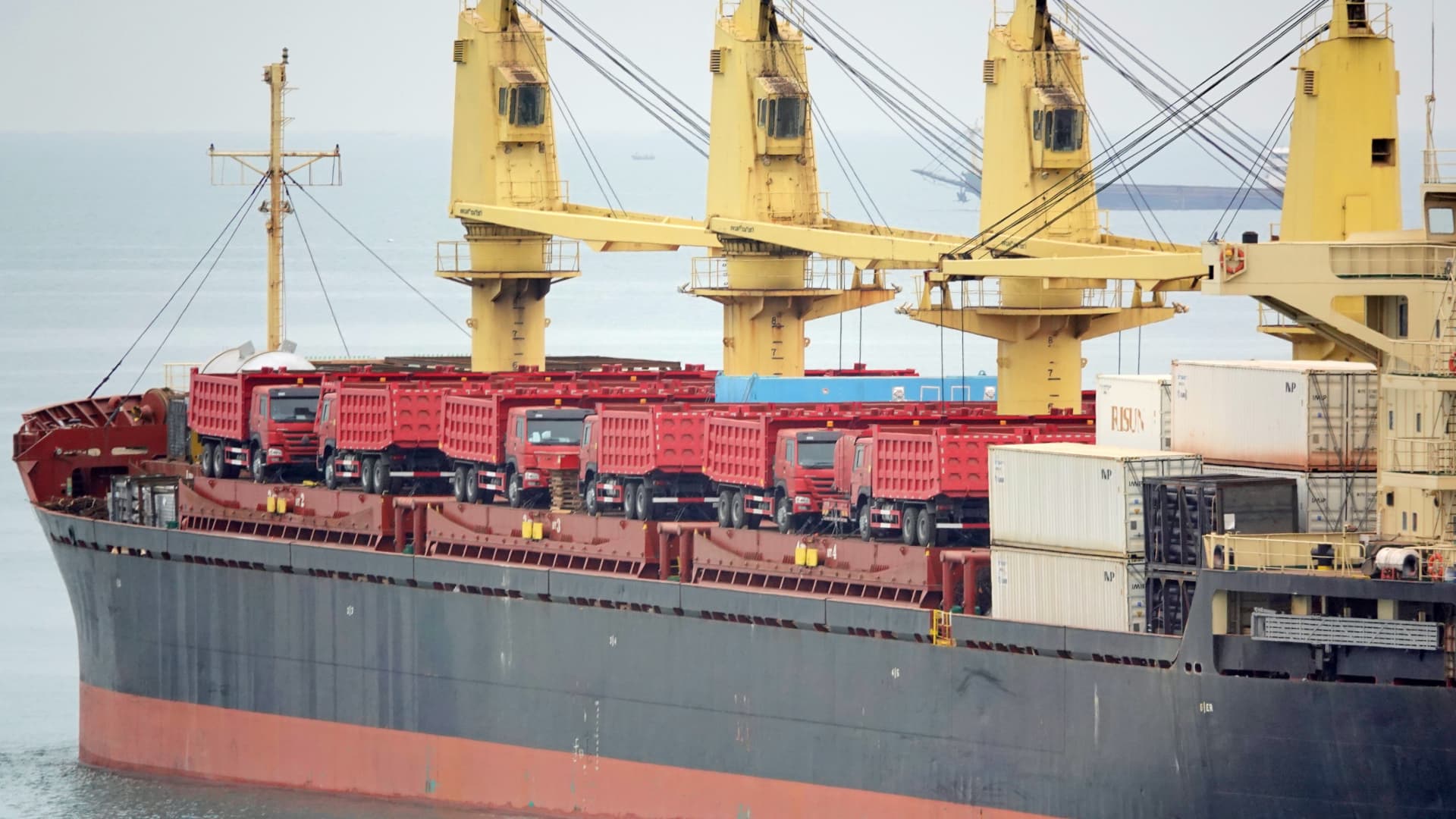Pictured right here is a cargo ship crusing from China’s Yantai port to Indonesia on April 23, 2023.
Future Publishing | Future Publishing | Getty Images
BEIJING — China can’t simply rely on its neighbors as export markets in a international slowdown, the most recent commerce knowledge present.
Exports to the Association of Southeast Asia Nations have been growing. The 10-member bloc surpassed the European Union through the pandemic to grow to be China’s largest buying and selling associate on a regional foundation.
Data confirmed that exports to Southeast Asia fell by 16% in May in contrast to a yr in the past, dragging down China’s overall exports.
Exports to the U.S. — China’s largest buying and selling associate on a single-country foundation — fell by 18% from a yr in the past in U.S. greenback phrases in May. That’s in accordance to official figures accessed by means of Wind Information.
At $42.48 billion, the U.S. exports in May have been greater than the $41.49 billion China exported to Southeast Asia that month, according to customs data.
Southeast Asia can’t absolutely offset the loss from the U.S. market, stated Bruce Pang, chief economist and head of analysis for Greater China at JLL.
ASEAN is made up of 10 nations: Brunei, Cambodia, Indonesia, Laos, Malaysia, Myanmar, the Philippines, Singapore, Thailand and Vietnam.
The U.S. is one single market versus a grouping of 10 nations, Pang identified, including that corporations may also promote at increased revenue margins within the U.S. market.
Trade has been a key driver of China’s development, particularly through the pandemic.
Exports nonetheless account for about 18% of the financial system, though that is nicely under the roughly 30% share it as soon as had, Tao Wang, head of Asia economics and chief China economist at UBS Investment Bank, instructed reporters Monday.
Drag from the U.S.
Slowing international development, particularly within the U.S. and Southeast Asia, does not bode nicely for the outlook on Chinese exports.
“We anticipate China’s exports will stay subdued, as we anticipate the US financial system to enter recession in H2 whereas international destocking pressures proceed to rise,” Lloyd Chan, senior economist at Oxford Economics, stated in a observe Wednesday.
Boosting commerce with growing nations has gained urgency with the closing of the US market and the EU-China funding deal falling aside after the Ukraine conflict.
Jack Zhang
University of Kansas, assistant professor of political science
Businesses within the U.S. have additionally been working through high inventory that did not get bought within the second half of final yr due to excessive inflation.
U.S. GDP is anticipated to gradual from 2.1% in 2022 to 1.6% this yr, in accordance to the International Monetary Fund.
Southeast Asia additionally slowing
ASEAN’s GDP is about to gradual to 4.6% growth this year, down from final yr’s 5.7% tempo, the IMF stated in April, when it trimmed its forecast for the area’s GDP development by 0.1 proportion factors.
“The sizeable hunch in May reaffirms our suspicion that China’s month-to-month export knowledge to some ASEAN economies – notably Vietnam, Singapore, Malaysia and Thailand — could also be considerably distorted,” Nomura economists stated in a observe Wednesday.
“Given the obvious plunge, exports to ASEAN has turned from a main driver to a drag, making a unfavourable contribution of -2.4pp to headline development in May.”
The U.S. and ASEAN every accounted for 15% of China’s complete exports in May, in accordance to CNBC calculations of Wind Information knowledge.
On a year-to-date foundation, the bloc has a barely increased share, at 16% of China’s exports versus the United States’ 14% share, the information confirmed.
“Looking ahead, [China’s] exports are possible to shrink additional on a excessive base, the deepening international manufacturing downturn and intensifying commerce sanctions from the West,” the Nomura analysts stated.
Regional commerce technique
The export declines come as U.S.-China relations stay tense, and Beijing has sought to bolster commerce with the growing nations in Asia Pacific.
“It’s 20-25% costlier to promote a number of stuff to the US, notably intermediate items like machine components,” Jack Zhang, assistant professor of political science on the University of Kansas, instructed CNBC in an e mail.
“Boosting commerce with growing nations has gained urgency with the closing of the US market and the EU-China funding deal falling aside after the Ukraine conflict,” he stated.
The 10-nation bloc — together with Japan, South Korea, Australia and New Zealand — signed a free commerce settlement with China in 2020. The Regional Comprehensive Economic Partnership or RCEP is the largest such deal in the world.
Beijing has stated it might additionally like to be a part of one other commerce bloc — the Comprehensive and Progressive Agreement for Trans-Pacific Partnership. The U.S. shouldn’t be a part of the CPTPP, whereas the U.K. announced a deal to join it in March.
RCEP has boosted China’s commerce with ASEAN, as has the shift of some labor-intensive manufacturing to the area, Zhang stated.
Meanwhile, he famous that “China has been ramping up negotiations for China-ASEAN FTA (CAFTA 3.0), it is exploring FTAs with Mercusor in LatAm and the Gulf Cooperation Council (GCC).”
The Mercusor commerce bloc contains Argentina, Brazil, Paraguay, and Uruguay.
— CNBC’s Clement Tan contributed to this report.

